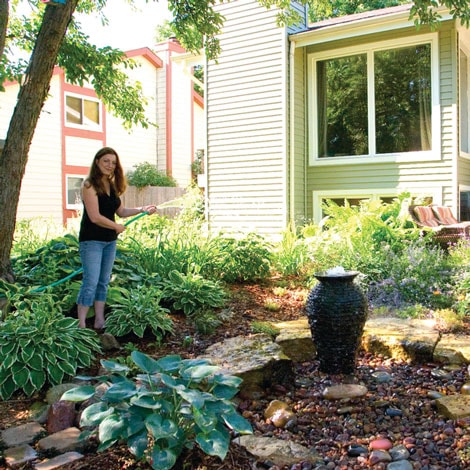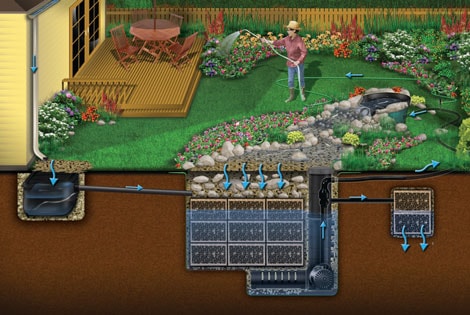Harvesting rain in a retention pond is a sustainable stormwater management and conservation solution. You can capture, filter, and reuse rain and storm runoff to water your plants, build a pondless waterfall feature or bubbling vase, or create a lush rain garden or water garden.
Many states periodically experience drought and water shortages, so it is important to conserve water, especially if you live in the arid Southwest. Collecting and using rainwater can help reduce high water bills and allow you to avoid strict water usage schedules instituted by your local water supply during hot, dry periods. Retention ponds also manage stormwater and prevent flooding in prone areas.
What is a Stormwater Retention Pond?
A retention pond is used to harvest rainwater and store it for later use. It consists of a rainwater catchment basin placed in a low-elevation area where water tends to pool. Concrete inlets are installed to redirect the flow of water into the retention pond, thus minimizing flooding in surrounding areas like roads and yards.
Retention ponds intended for use as a backyard rain garden have additional elements installed, like filters and water features. Often, a smaller bog pond serves as the initial catchment basin, with a dam and spillway controlling the flow of water into a larger main pond.
Rain gardens can also be pondless, with buried reservoirs containing the majority of the water. Fountains, streams, waterfalls, or features above the surface circulate and aerate the rainwater and lend a beautiful aesthetic to any outdoor space.
How to Build a Retention Pond
Building a bog filter with an outlet leading to a larger pond is one of the easiest ways to collect and filter rainwater. Use PVC pipes to direct water that flows from your roof gutters and into your downspouts to your bog filter instead of onto your lawn.
The rainwater will pass a series of filters that are hidden from view, removing leaves, twigs, seeds, and small sediment before it flows through a waterfall filter and into the main pond or an underground storage basin.
Building a Rain Garden
You can use the collected rainwater as a foundation for a lush and sustainable garden oasis. There are many different decorative features that you can place on top of the water reservoir to fit your style and space. Choose from copper trees, granite spheres, antique steel cups, or basalt stone. Sow your favorite plants nearby to catch the mist from these water features, or plant them on the banks of a decorative stream.
Harvesting Rainwater in Your Pond
Whether you decide to use rainwater collection for your garden, to do household chores, or to turn rainwater into a decorative waterfall or pondless water feature, collecting water with a rain harvesting system is great for the environment and can be financially beneficial. If you have more pond-building questions, contact us online or call 866-POND-HELP for prompt and friendly advice.
Explore these related articles to learn more:
Should I build a pond or pondless feature?
How to Build a Backyard Stream
Last Updated: February 12, 2025

